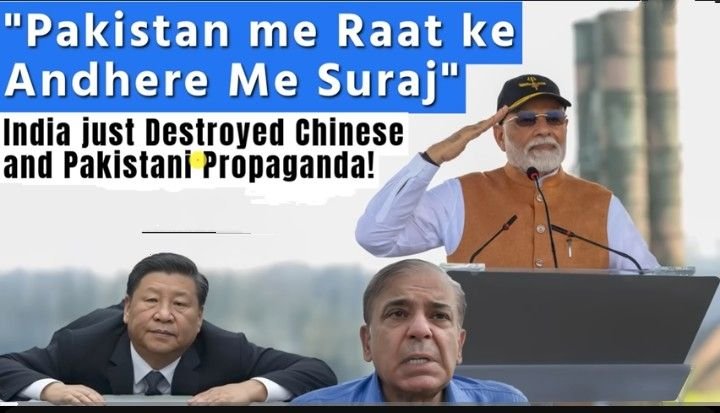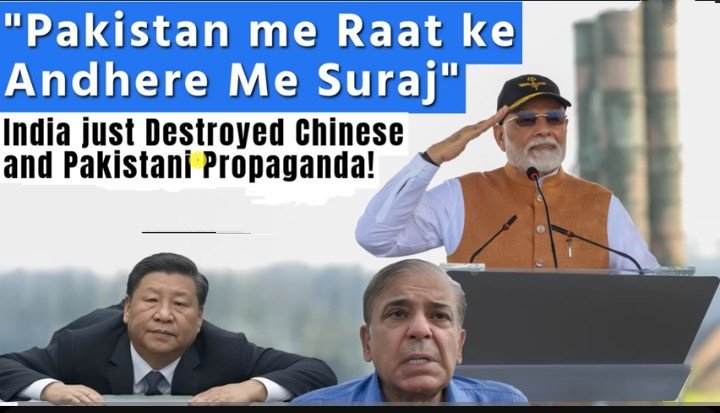
India’s Information Warfare Victory Against Pakistan and China: A Strategic Masterstroke
In recent times, India has not only strengthened its physical military capabilities but also decisively triumphed in the field of information warfare. Prime Minister Narendra Modi recently referred to this as “bringing daylight in the dead of night,” a direct jibe at the misinformation campaigns launched by Pakistan and China. Through strategic clarity, satellite evidence, and symbolic gestures, India has silenced propaganda and demonstrated unmatched credibility to the global community.
PM Modi’s Symbolic Visit to Adampur Airbase
Pakistan had falsely claimed that it struck the Adampur Airbase in India, attempting to create a narrative of success in its military offensive. In response, Prime Minister Modi made a powerful move—he visited Adampur Airbase himself. Standing tall before India’s mighty S-400 missile defense system and fighter jets, he sent a clear message: the base is untouched, fully operational, and the claims made by Pakistan are nothing but fabricated lies.
Images from the visit were iconic and widely circulated. They showcased India’s resilience and decisiveness, directly dismantling Pakistan’s fabricated narrative. This gesture alone served as a potent counter to enemy propaganda.
Pakistan’s Air Force – A House of Cards
Pakistan Air Force’s spokesperson, Aurangzeb, became the subject of mockery after attempting to justify their claims using absurd technical jargon. He referred to the S-400 as a “center of gravity”—a term clearly misused without understanding. His statements reflected the lack of scientific temper and the widespread misinformation fed to the Pakistani public. Their evidence, mostly recycled satellite images, failed to show any real damage or even credible targeting.
India’s Strategic Display of Evidence
India didn’t just rely on rhetoric. The government showcased actual satellite images to the world, proving that:
- The S-400 systems at Adampur were intact.
- No damage occurred at the site, contrary to Pakistan’s claims.
- India, in fact, struck key Pakistani terror camps and military installations using precision-guided strategies.
This not only exposed Pakistan’s lies but also shattered the credibility of their armed forces and leadership on a global stage.
Chinese Connection and the Fallout
Interestingly, the impact of India’s bold stand was also felt in China. Chengdu Aerospace Corporation, the Chinese defense company that manufactures the JF-17 and J-10 jets, saw its stocks fall by 7–8% after India’s strong counter to misinformation. This drop indicated investors’ shaken confidence in Chinese defense exports, especially when their equipment failed to perform as expected against Indian countermeasures.
Furthermore, missiles like the Chinese PL-15, supplied to Pakistan, were recovered mostly undamaged in Indian territory—signifying critical failures in their deployment. This clearly undermines the credibility of Chinese missile technology and its reliability in actual combat scenarios.
Pakistan’s HQ-9 System Debacle
Pakistan’s reliance on the Chinese HQ-9 air defense system, touted as a cheap imitation of the S-400, turned out to be a strategic blunder. India successfully neutralized the HQ-9 using simple drones, raising serious questions about the system’s effectiveness. Ironically, China itself doesn’t fully trust HQ-9, as it has procured S-400s from Russia for its own defense needs.
This raises a crucial question for Pakistan: If even China doesn’t rely solely on its own systems, why should Pakistan?
Project Kusha and Future Readiness
India, on the other hand, is working on Project Kusha, a mission to develop indigenous long-range air defense systems. While the S-400 remains a key asset, India is not complacent. Collaborations with Russia on next-gen systems like the S-500 are being explored. Unlike Pakistan, India is transparent and honest about its defense gaps and is actively working on addressing them with a long-term vision.
Western Media and Biased Narratives
Western media outlets, including the BBC, have occasionally published emotionally charged stories such as “the sky turned red in Pakistan”—aiming to generate sympathy for Pakistan. However, they often ignore or underreport India’s precision strikes, successful missile interceptions, and evidence-based rebuttals to Pakistani propaganda.
India’s actions have spoken louder than any statement. With transparency, technology, and truth, India has ensured that its voice is heard loud and clear on the global stage.
Conclusion: India’s Clear Upper Hand
India’s approach to modern warfare—especially information warfare—has been disciplined, effective, and precise. From exposing Pakistan’s fake claims to questioning the credibility of Chinese defense exports, New Delhi has secured not only its borders but also its narrative.
